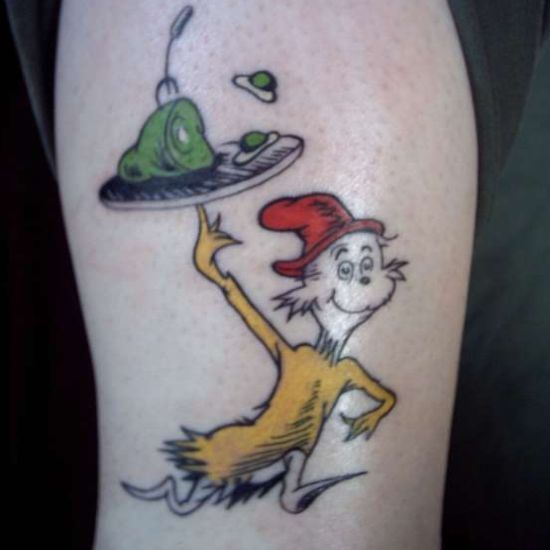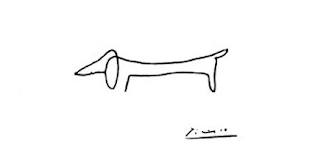Archive for the ‘Technology’ Category
The Flux Lines of Innovation
 There are countless books, tools, processes, methodologies and frameworks for innovation.
There are countless books, tools, processes, methodologies and frameworks for innovation.
And cutting across all theory and practice, the biggest fundamental of innovation is fear.
We define fear as bad because it limits new thinking and new actions, but there’s another way to look at it. We should look at fear as a leading indicator of innovation potential.
When inputs, outputs, or contexts are different than expectations, our bodies create physical symptoms we recognize as fear. It’s this chemical change in the body, manifested as cold sweats, tingling hands, difficulty in breathing, or knotted stomachs, that’s the tell-tale sign innovation is in the house.
If things are predictable, knowable, understandable, there is no fear. And if things are predictable, knowable, understandable there is no innovation. By the associative theorem: no fear, no innovation.
We should learn to use our bodies as innovation barometers. When pressure builds, especially when we don’t know why, we should recognize our fear, not as a blocker of innovation, but as a leading indicator of it.
Innovation, especially the type that reinvents, is not an in-the-head thing, it’s an in-the-chest thing. It’s indescribable, un-scriptable, and almost spiritual. Just as migratory birds sense weak magnetic fields to guide themselves home, we can use our bodies to sense fear and guide ourselves along the flux lines of innovation.
Fear is scary and can be uncomfortable. But for innovation, it’s scarier if there’s no fear.
What They Didn’t Teach Me in Engineering School
 The technical stuff is the easy part. Technical systems respond predictably, but people don’t.
The technical stuff is the easy part. Technical systems respond predictably, but people don’t.
There’s nothing worse than solving the wrong problem, so before you start solving you’ve better done a whole lot of defining.
There is no exact answer; engineering is all about judgment.
Organizational structure is important. Whatever the structure, see its strengths and make them work for you. If you try to fight it, it will eat you.
Innovation isn’t about ideas, innovation is about commercializing ideas.
Engineering analysis can win minds, but not hearts. And hearts govern minds.
The engineer’s role is not to minimize risk; it’s to understand the commercial reward and take risk accordingly.
What people believe is far more powerful than what they think.
New technology threatens status quoers, and, in turn, they block it.
There is no problem unless someone important thinks there’s one.
All technical systems are really human systems masquerading as technical systems.
If you let it, fear dominates. Be afraid and do it anyway. But along the way, keep in mind that others are too afraid to try.
Engineering is not sane and rational; engineering is about people.
Starvation, Pressure, and Perspective Shift
I like Dave Snowden’s thinking on innovation – starvation, pressure, and perspective shift. Here’s what it means to me:
Starvation – Left to our own, we’ll do as we did before. Starvation of resources pushes thinking away from stale, worn paths. Almost in reverse, define what you don’t want, then construct intelligent constraints (the most difficult part of the whole deal) so it’s out of the design space. Constrain the team so they can’t use the most expensive material; constrain the team so they can’t use the same old technology; constrain them so they can’t use the tried and true business model. It’s reverse thinking, but constraints – telling them what they can’t do – frees up design space. Constraints say “Do anything you want, except this.” which constrains far less than specifications. Constrain them to free them.
Pressure – Left to our own, we’ll reuse old thinking. Time pressure drags thinking out of the ruts of our success. Define creative constraints then, to create pressure, give the team insufficient time to think it through. Force them to swim differently with the problem. The best way I know is to explain the constraints then give the team fifteen minutes to build a prototype. (Yes, fifteen.) The prototype is non-functional, and can be made from whatever is on hand – cardboard, clay, duct tape, or packing peanuts. The short time frame creates pressure, and the pressure extrudes different thinking. Building a prototype shifts from learning-in-the-brain to learning-with-the-hands. And since hands learn differently than brains, new thinking is cast.
Perspective Shift – Left to our own, we’ll do a remake. Perspective shift moves us to a different place to create a healthy disrespect for today’s thinking. Seen in the right new light, our successes should look problematic. (From the front a skunk isn’t so bad, but from behind things aren’t so good.) Building a bridge to a new perspective can shift things a little, but for a tectonic shift, formalize the consequences of inaction. Think – “If we don’t do this, a very bad thing will happen.” Perspective shift is all about creating action in a new direction.
You won’t get it right the first time, but, no matter. The real enemy is inaction.
Error Doesn’t Matter, Trial Does
 If you want to learn, to really learn, experiment.
If you want to learn, to really learn, experiment.
But I’m not talking about elaborate experiments; I’m talking about crude ones. Not simple ones, crude ones.
We were taught the best experiments maximize learning, but that’s dead wrong. The best experiments are fast, and the best way to be fast is to minimize the investment.
In the name of speed, don’t maximize learning, minimize the investment.
Let’s get right to it. One of the best tricks to minimize investment is to minimize learning – learning per experiment, that is. Define learning narrowly, design the minimum experiment, and run the trial. Learning per trial is low, but learning per month skyrockets because the number of trials per month skyrockets. But it gets better. There’s an interesting learning exponential at work. The first trial informs the second which shapes the third. But instead of three units of learning, it’s cubic. And minimizing learning doesn’t just half the time to run a trial, it reduces it by 100 or more. It’s earning to the hundredth power.
Another way to minimize investment is to minimize resolution. Don’t think nanometers, think thumbs up, thumbs down. Design the trial so the coarsest measuring stick gives an immediate and unambiguous response. There’s no investment in expensive measurement gear and no time invested in interpretation of results. Think sledgehammer to the forehead.
A third way to minimize investment is to evaluate relative differences. The best example is the simple, yet powerful, A-B test . Run two configurations, decide which is better, and run quickly in the direction of goodness. No need to fret about how much better, just sprint toward it. The same goes for trial 1 versus trial 2 comparisons. Here’s the tricky algorithm: If trial 2 is better, do more of that. And the good news applies here too – the learning exponential is still in play. Better to the hundredth power, in record time.
I don’t care what norms you have to bend or what rules you have to break. If you do one thing, run more trials.
But don’t take my word for it. Dr. Seuss had it right:
And I would run them in a boat!
And I would run them with a goat…
And I will run them in the rain.
And in the dark. And on a train.
And in a car. And in a tree.
They are so good so good you see!
Engineering Will Carry the Day
 Engineering is more important than manufacturing – without engineering there is nothing to make, and engineering is more important than marketing – without it there is nothing to market.
Engineering is more important than manufacturing – without engineering there is nothing to make, and engineering is more important than marketing – without it there is nothing to market.
If I could choose my competitive advantage, it would be an unreasonably strong engineering team.
Ideas have no value unless they’re morphed into winning products, and that’s what engineering does. Technology has no value unless it’s twisted into killer products. Guess who does that?
We have fully built out methodologies for marketing, finance, and general management, each with all the necessary logic and matching toolsets, and manufacturing has lean. But there is no such thing for engineering. Stress analysis or thermal modeling? Built a prototype or do more thinking? Plastic or aluminum? Use an existing technology or invent a new one? What new technology should be invented? Launch the new product as it stands or improve product robustness? How is product robustness improved? Will the new product meet the specification? How will you know? Will it hit the cost target? Will it be manufacturable? Good luck scripting all that.
A comprehensive, step-by-step program for engineering is not possible.
Lean says process drives process, but that’s not right. The product dictates to the factory, and engineers dictate the product. The factory looks as it does because the product demands it, and the product looks as it does because engineers said so.
I’d rather have a product that is difficult to make but works great rather than one that jumps together but works poorly.
And what of innovation? The rhetoric says everyone innovates, but that’s just a nice story that helps everyone feel good. Some innovations are more equal than others. The most important innovations create the killer products, and the most important innovators are the ones that create them – the engineers.
Engineering as a cost center is a race to the bottom; engineering as a market creator will set you free.
The only question: How are you going to create a magical engineering team that changes the game?
How Engineers Create New Markets
 When engineers see a big opportunity, we want desperately to move the company in the direction of our thinking, but find it difficult to change the behavior of others. Our method of choice is usually a full frontal assault, explaining to anyone that will listen the opportunity as we understand it. Our approach is straightforward and ineffective. Our descriptions are long, convoluted, complicated, we use confusing technical language all our own, and omit much needed context that we expect others should know. The result – no one understands what we’re talking about and we don’t get the behavior we’re looking for (immediate company realignment with what we know to be true). Then, we get frustrated and shut down – opportunity lost.
When engineers see a big opportunity, we want desperately to move the company in the direction of our thinking, but find it difficult to change the behavior of others. Our method of choice is usually a full frontal assault, explaining to anyone that will listen the opportunity as we understand it. Our approach is straightforward and ineffective. Our descriptions are long, convoluted, complicated, we use confusing technical language all our own, and omit much needed context that we expect others should know. The result – no one understands what we’re talking about and we don’t get the behavior we’re looking for (immediate company realignment with what we know to be true). Then, we get frustrated and shut down – opportunity lost.
To change the behavior of others, we must first change our own. As engineers we see problems which, when solved, result in opportunity. And if we’re to be successful, we must go back to the problem domain and set things straight. Here’s a sequence of new behaviors we as engineers can take to improve our chances of changing the behavior of others:
Step 1. Create a block diagram of the physical system using simple nouns (blocks) and verbs (arrows). Blue arrows are good (useful actions) and red arrows are bad (harmful actions). Here’s a link to a PowerPoint file with a live template to create your own.
Step 2. Reduce the system block diagram down to its essence to create a distilled block diagram of the problem, showing only the system elements (blocks) with the problem (red arrow).For a live template, see the second page of the linked file. [Note – if there are two red arrows in the system block diagram, there are two problems which must be solved separately. Break them into two and solve the first one first. For an example, see page three of the linked file.]
Step 3. Create a hand sketch, or cartoon, showing the two system elements (blocks) of the distilled block diagram from step 2. Zoom in so only the two elements are visible, and denote where they touch (where the problem is), in red. For an example, see page four of the linked file.
Step 4. Now that you understand the real problem, use Google to learn how others have solved it.
Step 5. Choose one of Google’s most promising solutions and prototype it. (Don’t ask anyone, just build it.)
Step 6. Show the results to your engineering friends. If the problem is solved, it’s now clear how the opportunity can be realized. (There’s a big difference between a crazy engineer with a radically new market opportunity and a crazy engineer with test results demonstrating a new technology that will create a whole new market.)
Step 7. If the problem is not solved, or you solved the wrong problem, go back to step 1 and refine the problem
With step 1 you’ll find you really don’t understand the physical system, you don’t know which elements of the system have the problem, and you can’t figure out what the problem is. (I’ve created complicated system block diagrams only to realize there was no problem.)
With step 2, you’ll continue to struggle to zoom in on the problem. And, likely, as you try to define the problem, you’ll go back to step 1 and refine the system block diagram. Then, you’ll struggle to distill the problem down to two blocks (system elements). You’ll want to retain the complexity (many blocks) because you still don’t understand the real problem.
If you’ve done step 2 correctly, step 3 is easy, though you’ll still want to complicate the cartoon (too many system elements) and you won’t zoom in close enough.
Step 4 is powerful. Google can quickly and inexpensively help you see how the world has already solved your problem.
Step 5 is more powerful still.
Step 6 shows Marketing what the future product will do so they can figure out how to create the new market.
Step 7 is how problems are really solved and opportunities actually realized.
When you solve the real problem, you create real opportunities.
Guided Divergence
 We’ve been sufficiently polluted by lean and Six Sigma, and it’s time for them to go.
We’ve been sufficiently polluted by lean and Six Sigma, and it’s time for them to go.
Masquerading as maximizers, these minimizers-in-sheep’s-clothing have done deep harm. Though Six Sigma is almost dead (it’s been irrelevant for some time now), it has made a lasting mark. Billed as a profit maximizer, it categorically rejects maximization. In truth, it’s a variation minimizer and difference reducer. If it deviates, Six Sigma cuts its head off. Certainly this has a place in process control, but not in thinking control. But that’s exactly what’s happened. Six Sigma minimization has slithered off the manufacturing floor and created a culture of convergence. If your thinking is different, Six Sigma will clip it for you.
Lean is worse. All the buzz around lean is about maximizing throughput, but it doesn’t do that. It minimizes waste. But far worse is lean’s standard work. Minimize the difference among peoples’ work; make them do it the same; make the factory the same, regardless of the continent. All good on the factory floor, but lean’s minimization mania has spread like the plague and created a culture of convergence in its wake. And that’s the problem – lean’s minimization-standardization mantra has created a culture of convergence. If your thinking doesn’t fit in, lean will stomp it into place.
We need maximization at the expense of minimization, and divergence before convergence. We need creativity and innovation. But with Six Sigmaphiles and lean zealots running the show, maximization is little understood and divergence is a swear.
First we must educate on maximization. Maximization creates something that had not existed, while minimization reduces what is. Where Six Sigma minimization converges on the known right answer, creativity and innovation diverge to define a new question. The acid test: if you’re improving something you’re minimizing; if you’re inventing something you’re maximizing.
Like with He Who Shall Not Be Named, it’s not safe to say “diverge” out loud, because if you do, the lean Dementors will be called to suck out your soul. But, don’t despair – the talisman of guided divergence can save you.
With guided divergence, a team is given a creatively constructed set of constraints and very little time (hours) to come up with divergent ideas. The constraints guide the creativity (on target), and the tight timeline limits the risk – a small resource commitment. (Though counterintuitive, the tight timeline also creates remarkable innovation productivity.) Done in sets, several guided divergence sessions can cover a lot of ground in little time.
And the focused/constrained nature of guided divergence appeals to our minimization bias, and makes it okay to try a little divergence. We feel safe because we’re deviating only a little and only for a short time.
Lean and Six Sigma have served us well, and they still have their place. (Except for Six Sigma.) But they must be barred from creativity sessions and front end innovation, because here, divergence carries the day.
Circle of Life
Engineers solve technical problems so
Other engineers can create products so
Companies can manufacture them so
They can sell them for a profit and
Use the wealth to pay workers so
Workers can support their families and pay taxes so
Their countries have wealth for good schools to
Grow the next generation of engineers to
Solve the next generation of technical problems so…
Beyond Dead Reckoning
 We’re afraid of technology development because it’s risky. And figuring out where to go is the risky part. To figure out where to go companies use several strategies: advance multiple technologies in parallel; ask the customer; or leave it to company leader’s edict. Each comes with its strengths and weaknesses.
We’re afraid of technology development because it’s risky. And figuring out where to go is the risky part. To figure out where to go companies use several strategies: advance multiple technologies in parallel; ask the customer; or leave it to company leader’s edict. Each comes with its strengths and weaknesses.
I think the best way to figure out where to go is to figure out where you are. And the best way to do that is data-driven S-curve analysis.
To collect data, look to your most recent product launches, say five, and characterize them using a goodness-to-cost ratio. (Think miles per gallon for your technology.) Then plot them chronologically and see how the goodness ratio has evolved – flat, slow growth, steep growth, or decline. The shape of the curve positions your technology within the stages of the S-curve and its location triangulated with contextual clues. You know where you are so you can figure out where to go.
Here’s what the stages feel like and what to do when you’re in them:
Stage 1: Infancy – New physics are used to deliver a known function, but it’s not ready for commercialization. This is like early days of the gasoline-electric hybrid vehicles, where the physics of internal combustion was combined with the physics of batteries. In Stage 1 the elements of the overall system are established, like when Honda developed its first generation Honda Insight and GM its EV1. Prototypes are under test, and they work okay, but not great. In Stage 1, goodness-to-cost is lower than existing technologies (and holding), but the bet is when they mature goodness-to-cost will be best on the planet.
If your previous products were Stage 4 (Maturity) or Stage 5 (Decline), your new project should be in Stage 1. If your existing project is in Stage 1, focus on commercialization. If all your previous projects were (are) in Stage 1, you should focus on commercializing one (moving to Stage 2) at the expense of starting a new one.
Stage 2: Transitional – A product is launched in the market and there is intense competition with existing technologies. In Stage 2, several versions of new technology are introduced (Prius, Prius pluggable, GM’s Volt, Nissan Leaf), and they fight it out. Goodness-to-cost is still less than existing technologies, but there’s some element of the technology that’s attractive. For electric vehicles, think emissions.
If your previous products were Stage 4 (Maturity) or Stage 5 (Decline) and your current project just transitioned from Stage 1, you’re in the right place. In Stage 2, fill gaps in functionality; increase controllability – better controls to improve battery performance; and develop support infrastructure -electric fueling stations.
Stage 3: Growth – Goodness-to-cost increases rapidly, and so do sales. (I think most important for an electric vehicle is miles per charge.)
If you’re in Stage 3, it’s time to find new applications – e.g., electric motorcycles, or shorten energy flow paths – small electric motors at the wheels.
Stage 4: Maturity – The product hits physical limits – flat miles per gallon; hits limits in resources – fossil fuels; hits economic limits – costly carbon fiber body panels to reduce weight; or there’s rapid growth in harmful factors – air pollution.
If you’re in Stage 4, in the short term add auxiliary functions – entertainment systems, mobile hotspot, heated steering wheel, heated washer fluid; or improve aesthetics – like the rise of the good looking small coupe. In the long term, start a Stage 1 project to move to new physics – hydrogen fuel cells.
Stage 5: Decline – New and more effective systems have entered their growth stage – Nissan Leaf outsells Ford pickup trucks.
If you’re in Stage 5, long ago you should have started at Stage 1 project – new physics. If you haven’t, it may be too late.
S-curve analysis guides, but doesn’t provide all the answers. That said, it’s far more powerful than rock-paper-scissors.
(This thinking was blatantly stolen from Victor Fey’s training on Advanced S-Curve Analysis. Thank you, Victor.)
More Risk, Less Consequence
 WHY? To grow sales in existing markets and create sales in new markets.
WHY? To grow sales in existing markets and create sales in new markets.
WHAT? Create innovative technologies and design products with more function and less cost.
HOW? Educate the engineering engine.
This is easier said than done, because for years we’ve set one-sided expectations – new products must work and timelines must be met – and driven risk tolerance out of our engineering engine. Now it’s time to inject it back in.
The message – Our thinking must change. We must take more risk, but do it safely by reducing negative consequences of risk.
To reduce negative consequences of risk, we must learn to localize risk through the narrowest and deepest problem definition, and learn to secure the launch so it’s safe to try new things.
We must do more up-front technology work, but learn to do it far more narrowly and deeply. We must learn to hold ourselves accountable to rigorous problem definition, and we must put our best people on technology projects.
To focus creativity we must learn to set seemingly unrealistic time constraints; to focus our actions we can look to a powerful mantra – spend a little, learn a lot.
The trouble with new thinking is it takes new thinking. If you don’t have it, go get it. If you already have it, figure out why you haven’t used it.
Less-With-Far-Less for the Developing World
 The stalled world economy will make growth difficult, and companies are digging in for the long haul, getting ready to do more of what they do best – add more function and features, sell more into existing markets, and sell more to existing customers. More of the same, but better. But growth will not come easy with more-on-more thinking. It will be more-on-more trench warfare – ugly hand-to-hand combat with little ground gained. It’s time for another way. It’s time for less. It’s time to create new markets with less-with-far-less thinking.
The stalled world economy will make growth difficult, and companies are digging in for the long haul, getting ready to do more of what they do best – add more function and features, sell more into existing markets, and sell more to existing customers. More of the same, but better. But growth will not come easy with more-on-more thinking. It will be more-on-more trench warfare – ugly hand-to-hand combat with little ground gained. It’s time for another way. It’s time for less. It’s time to create new markets with less-with-far-less thinking.
Real growth will come from markets and consumers that don’t exist. Real (and big) growth will come from the developing world. They’re not buying now, but they will. They will when product are developed that fit them. But here’s the kicker – products for the developed world cannot be twisted and tweaked to fit. Your products must be re-imagined.
The fundamentals are different in the developing world. Three important ones are – ability to pay, population density, and literacy/skill.
The most important fundamental is the developing world’s ability to pay. They will buy, but to buy products must cost 10 to 100 times less. (No typo here – 10 to 100 times less.) Traditional cost reduction approaches such as Design for Manufacturing and Assembly (DFMA) won’t cut it – their 50% cost reductions are not even close. Reinvention is needed; radical innovation is needed; fundamental innovation is needed. Less-with-far-less thinking is needed.
To achieve 10-100X cost reductions, the product must do less and do it far more efficiency (with far less). Product functionality must be decimated – ripped off the bone until only bone remains. The product must do only one thing. Not two – one. The product must be stripped to its essence, and new technology must be developed to radically improve efficiency of delivering its essence. Products for the developing world will require higher levels of technology than products for the developed world.
Radical narrowing of functionality will make viable the smaller, immature, more efficient technologies. Infant technologies usually have lower output and less breadth, but that’s just what’s needed – narrow, deep, and less. Less-with-far-less.
In the developing world, population density is low. People are spread out, and rural is the norm. And it’s not developed world rural, it’s three-day-hike rural. In the developing world, people don’t go to products; products go to people. If it’s not portable, it won’t sell. And developing world portable does not mean wheels – it means backpack. Your products must fit in a backpack and must be light enough to carry in one.
Big, stationary, expensive equipment is not exempt. It also must fit in a backpack. And this cannot be achieved with twist-and-bend engineering. To fit in a backpack, the product must be stripped naked and new technology must be developed to radically improve efficiency. This requires radical narrowing, radical reimagining, and radical innovation. It requires less-with-far-less thinking. (And if it doesn’t run on batteries, it should at least have battery backup to deal with rolling blackouts.)
People in the developing world are intelligent, but most cannot read well and have little experience with developed world products. Where the developed world’s solution is picture-based installation instructions, less-with-far-less products for the developing world demand no instructions. For the developing world, the instruction manual is the on button. And this requires serious technology – software algorithms fed by low cost sensors. And the only way it’s possible is by distilling the product to its essence. Algorithms, yes, but algorithms to do only one thing very well. Less-with-far-less.
The developed world makes products with output that requires judgment – multi-colored graphical output that lets the user decide if things went well. Products for the developing world must have binary output – red/green, beep/no-beep. Less-with-far-less. But again, this seemingly lower-level functionality (a green light versus a digital display) actually requires more technology. The product must interpret results and decide if it’s good – much harder than a sexy graphical output that requires interpretation and judgement.
Creating products for the developing world requires different thinking. Instead of adding more functions and features, it’s about creating new technologies that do one thing very well (and nothing more) and do it with super efficiency. Products for the developing world require higher technologies than those for the developed world. And done well, the developed world will buy them. But the crazy thing is, the less-with-far-less products that will be a hit in the developing world will boomerang back and be an even bigger hit in the developed world.


 Mike Shipulski
Mike Shipulski